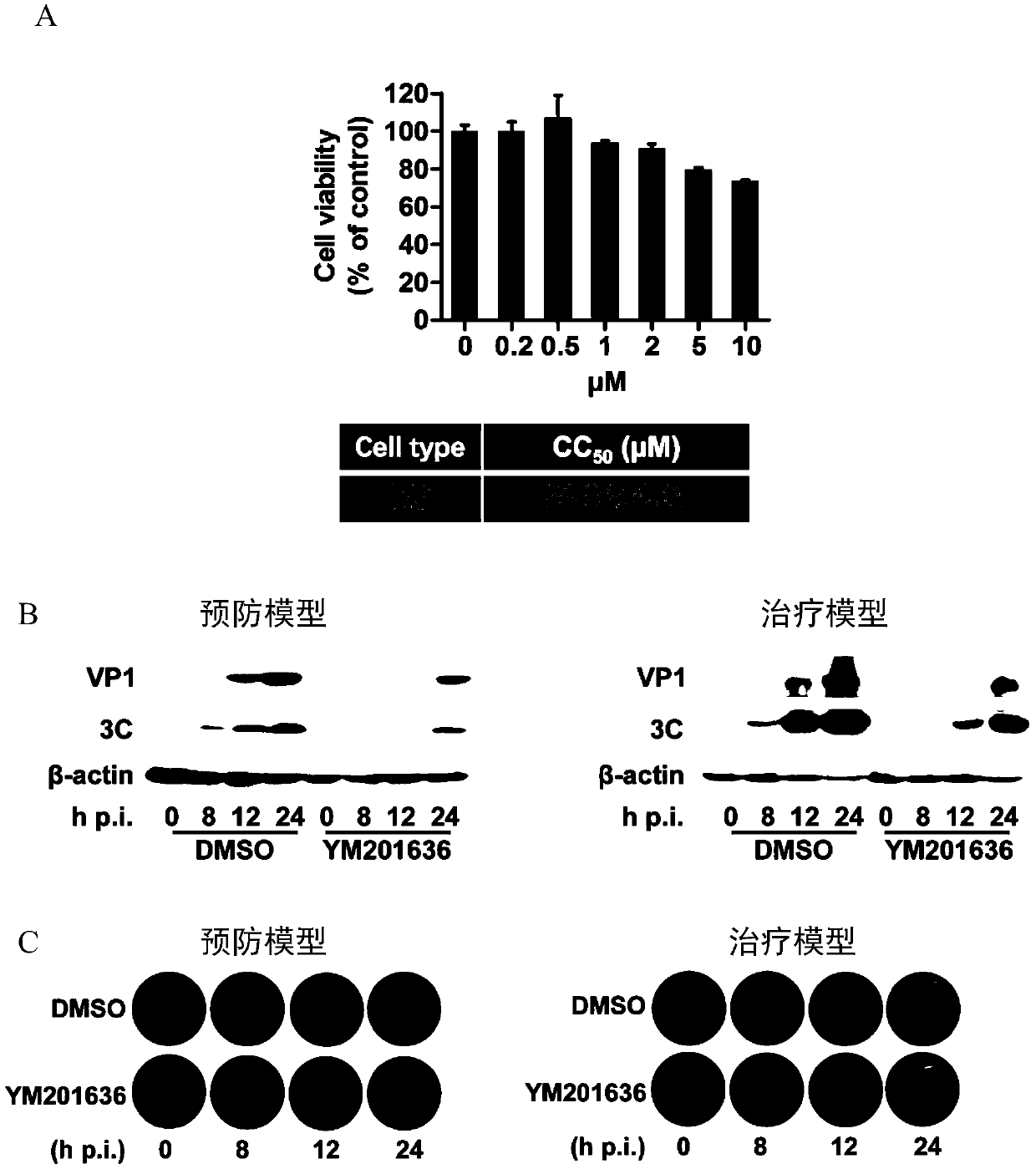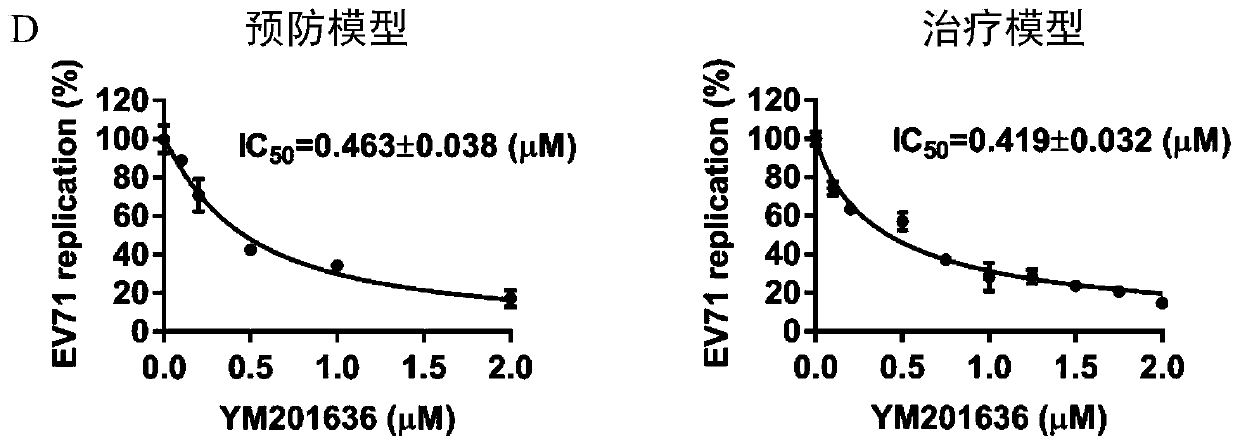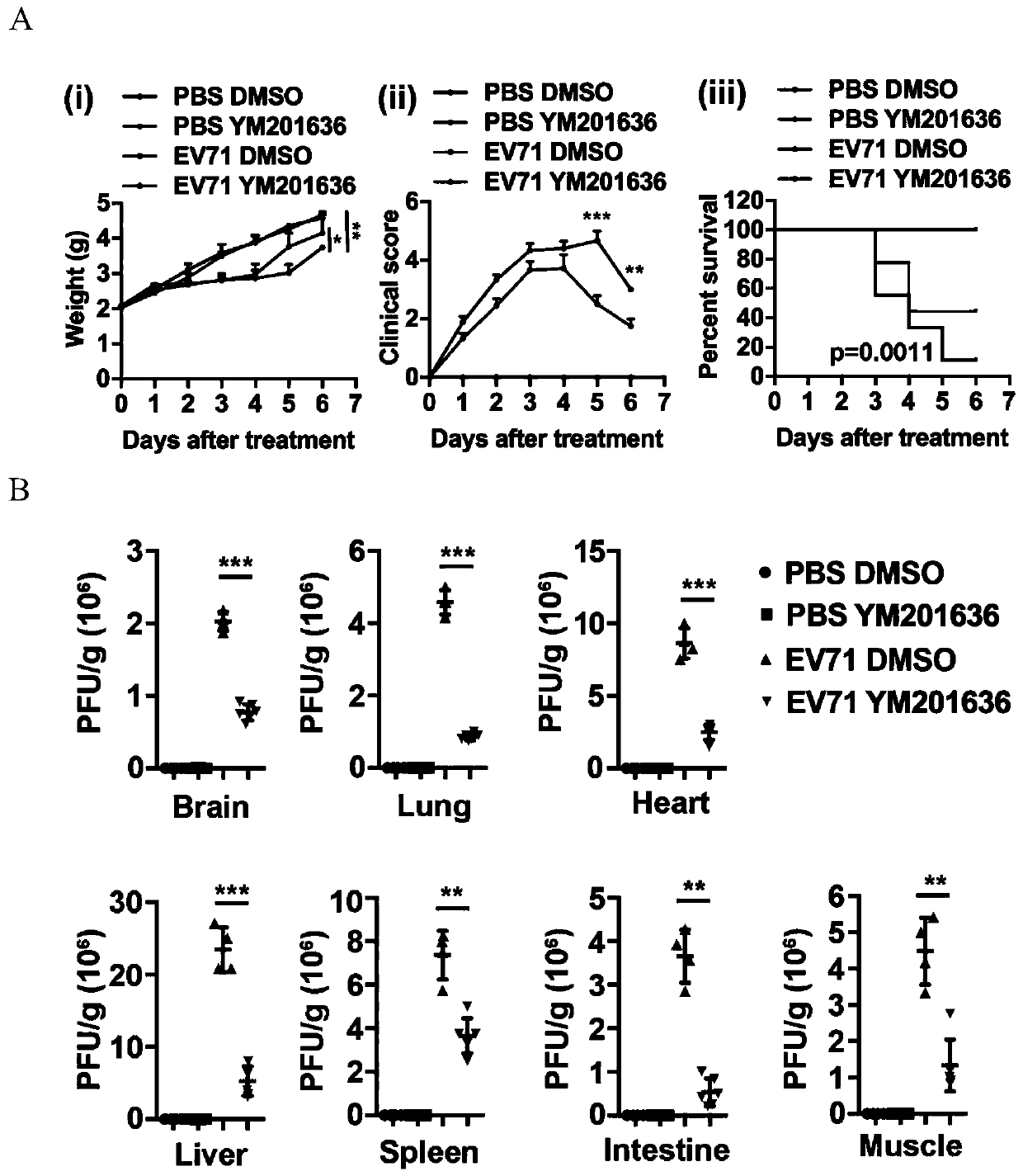Application of YM201636 and pharmaceutically acceptable salt thereof in preparation of drugs for resisting enterovirus infection
A technology of YM201636 and 1.YM20163 is applied in the application field of preparing anti-enterovirus infection drugs, which can solve the problems of limited number of infections, can only target a single, easy to produce drug resistance, etc., and achieve high-efficiency anti-enterovirus, The effect of wide application prospects
- Summary
- Abstract
- Description
- Claims
- Application Information
AI Technical Summary
Problems solved by technology
Method used
Image
Examples
Embodiment 1
[0039] 1. Experimental materials:
[0040] 1.1 Cells and viruses:
[0041]Human embryonic rhabdomyosarcoma (RD) cells (resource number: 3142C0001000000321) were obtained from the China Center for Type Culture Collection (CCTCC) (Wuhan, China). Enterovirus 71 (EV71) strain (Xiangyang-Hubei-09) was derived from the brain tissue of an infant who died of EV71 infection in Xiangyang, Hubei Province, China, and was previously isolated and preserved by the State Key Laboratory of Virology, Wuhan University (GenBank: JN230523.1), virus stocks were amplified in RD cells. The small molecule compound YM201636 was purchased from MCE (MedChemExpress) in the United States.
[0042] 2. Experimental methods and results:
[0043] 2.1 Cytotoxicity detection of YM201636 on RD cells
[0044] (1) Divide RD cells according to 5×10 5 Cells / well were seeded in a 12-well cell culture plate in DMEM medium containing 10% FBS and supplemented with 1% penicillin and streptomycin. at 37°C, 5% CO 2 c...
Embodiment 2
[0087] Embodiment 2: YM201636 inhibits the detection of EV71 replication activity in mice
[0088] The application of YM201636 in the preparation of medicines for treating or preventing enterovirus infection, the steps are:
[0089] 1. Experimental materials:
[0090] 1.1 Animals and viruses:
[0091] C57BL / 6WT mice were purchased from Shanghai Experimental Animal Center, and the mice were housed in individually ventilated cages under specific pathogen-free (SPF) conditions. Enterovirus 71 (EV71) strain (Xiangyang-Hubei-09) was derived from the brain tissue of an infant who died of EV71 infection in Xiangyang, Hubei Province, China, and was previously isolated from the State Key Laboratory of Virology, Wuhan University (GenBank: JN230523. 1), Virus stocks are amplified in RD cells. The small molecule compound YM201636 was purchased from MCE (MedChemExpress) in the United States.
[0092] 2. Experimental methods and results:
[0093] 2.1 Detection of the effect of YM201636...
Embodiment 3
[0105] Embodiment 3: the active detection of YM201636 anti-CVB3, PV1
[0106] The application of YM201636 in the preparation of medicines for treating or preventing enterovirus infection, the steps are:
[0107] 1. Experimental materials:
[0108] 1.1 Cells and viruses:
[0109] Human embryonic rhabdomyosarcoma (RD) cells were obtained from the China Center for Type Culture Collection (CCTCC) (Wuhan, China). CVB3 (Nancy strain) (preservation number: GDV015) and PV1 (vaccine strain) (preservation number: GDV057) were derived from the China Center for Type Culture Collection (CCTCC) (Wuhan, China), and the virus stocks were amplified in RD cells. The small molecule compound YM201636 was purchased from MCE (MedChemExpress) in the United States.
[0110] 2. Experimental methods and results:
[0111] CVB3 and PV1 infect RD cells, and the viruses produce dsRNA during intracellular replication. Therefore, the immunofluorescence technique was used to evaluate the level of virus r...
PUM
 Login to View More
Login to View More Abstract
Description
Claims
Application Information
 Login to View More
Login to View More - R&D
- Intellectual Property
- Life Sciences
- Materials
- Tech Scout
- Unparalleled Data Quality
- Higher Quality Content
- 60% Fewer Hallucinations
Browse by: Latest US Patents, China's latest patents, Technical Efficacy Thesaurus, Application Domain, Technology Topic, Popular Technical Reports.
© 2025 PatSnap. All rights reserved.Legal|Privacy policy|Modern Slavery Act Transparency Statement|Sitemap|About US| Contact US: help@patsnap.com



